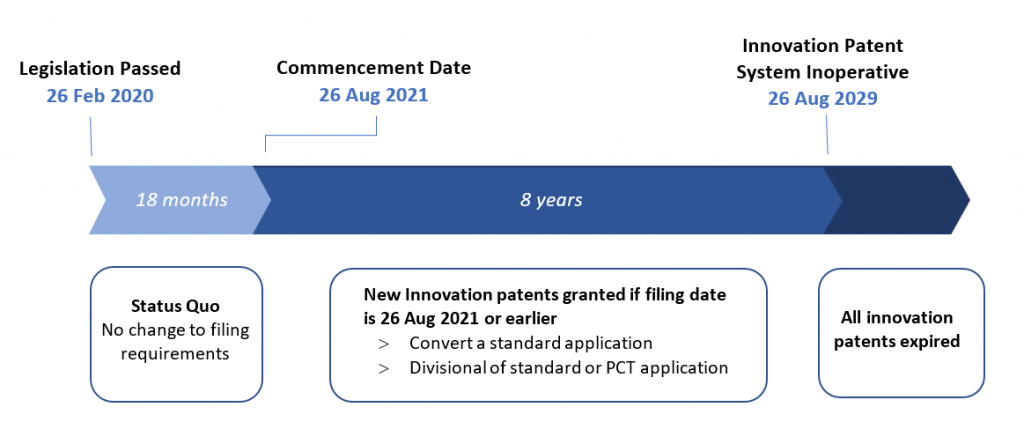On 26 February 2020, the Intellectual Property Amendment (Productivity Commission Response Part 2 and Other Measures) Bill 2019 finally passed into law. The legislations prime operation is the abolishment of Australia's unique Innovation Patent system. However, instead of the immediate repeal, the innovation patent will be phased out over 8 years from 26 August 2021 to 26 August 2029.
Key deadlines are as follows:
- Until 26 August 2021, there is no change and innovation patent applications may be freely filed, subject to existing limitations.
- After 26 August 2021, innovation patent applications will be granted if they have a filing date of 26 August 2021 or earlier. Pre-existing patent applications or PCT applications designating Australia with a filing date prior to 27 August 2021 may serve as the basis for a new divisional innovation patent application or be converted into an innovation patent application in the usual way.
- All granted innovation patent rights are entitled to a normal eight-year term however, by 26 August 2029, all innovation patents will have expired.
Background
In 2000, the Australian Government launched the innovation patent system which was designed to provide SME's with a cost-effective option for the protection of lower level inventions. Innovation patents are subject to the same novelty requirements as standard patents but must meet a less stringent threshold for inventiveness, referred to as an "innovative step". The trade-off for this lower patentability standard is a reduced eight-year term of protection and a five-claim limit. Substantive examination is not required prior to grant, thereby delivering potential cost savings to patentees.
Since its introduction, reaction to the innovation patent has been mixed. Supporters argue that it has provided exactly what it says on the tin, low-cost protection for lower tier innovations which have proved invaluable for SMEs. However, there has been growing resistance to the innovation patent for some time. In 2008, the "innovative step" test was reviewed by the Federal Court for the first time. Its decision that the test only required a point of differentiation between the claimed invention and the prior art contribution to the working of the invention, arguably gave the innovation patent more teeth than was ever intended, particularly since enforcement remedies are equal to those of standard patents.
By 2012, recommendations were afoot to amend the innovative step test to be more stringent. While those proposals were never progressed, the push to abolish the Innovation Patent regime was taken up by the Productivity Commission, ultimately concluding in the introduction of the Intellectual Property Amendment (Productivity Commission Response Part 2 and Other Measures) Bill 2019.
Phase-out of the Innovation Patent System
The new legislation introduces a requirement into the innovation patent formalities check in which the date of an innovation patent must be no later than 26 August 2021 (the commencement date). Effectively, the repeal mechanism is dormant for 18 months and any new innovation patent applications may be freely filed until the commencement date.
After the commencement date however, notwithstanding any pending innovation patents, new innovation patents will only be granted if derived from, or converted from, a pre-existing patent application with a filing date on or before the commencement date. Thus, it will remain possible to obtain an innovation patent, but only for subject matter disclosed in a patent application pre-existing at the commencement date. Significantly, 'filing date' is defined in Section 30 of the Patents Act and refers to the filing date of an Australian application (either standard or innovation) or the parent thereof, or the International filing date of a PCT application designating Australia.
Of course, the maximum term of an innovation patent is eight years from the filing date. Since no new innovation patents may be granted with a filing date later than the commencement date of 26 August 2021, all innovation patents will have expired by 26 August 2029, eight years from the commencement date.
The time-line below indicates the phase-out dates of the innovation patent system.

Implications
The adoption of the phase-out period should avoid any "mad-rush" by applicants to secure innovation patent rights. However, over the next 18 months, and particularly as 26 August 2021 approaches, innovators are advised to consider any IP in progress. It may be worthwhile accelerating pending provisional applications, or applications for inventions yet to be filed, in order to retain the option of accessing the innovation patent system.
The content of this article is intended to provide a general guide to the subject matter. Specialist advice should be sought about your specific circumstances.

